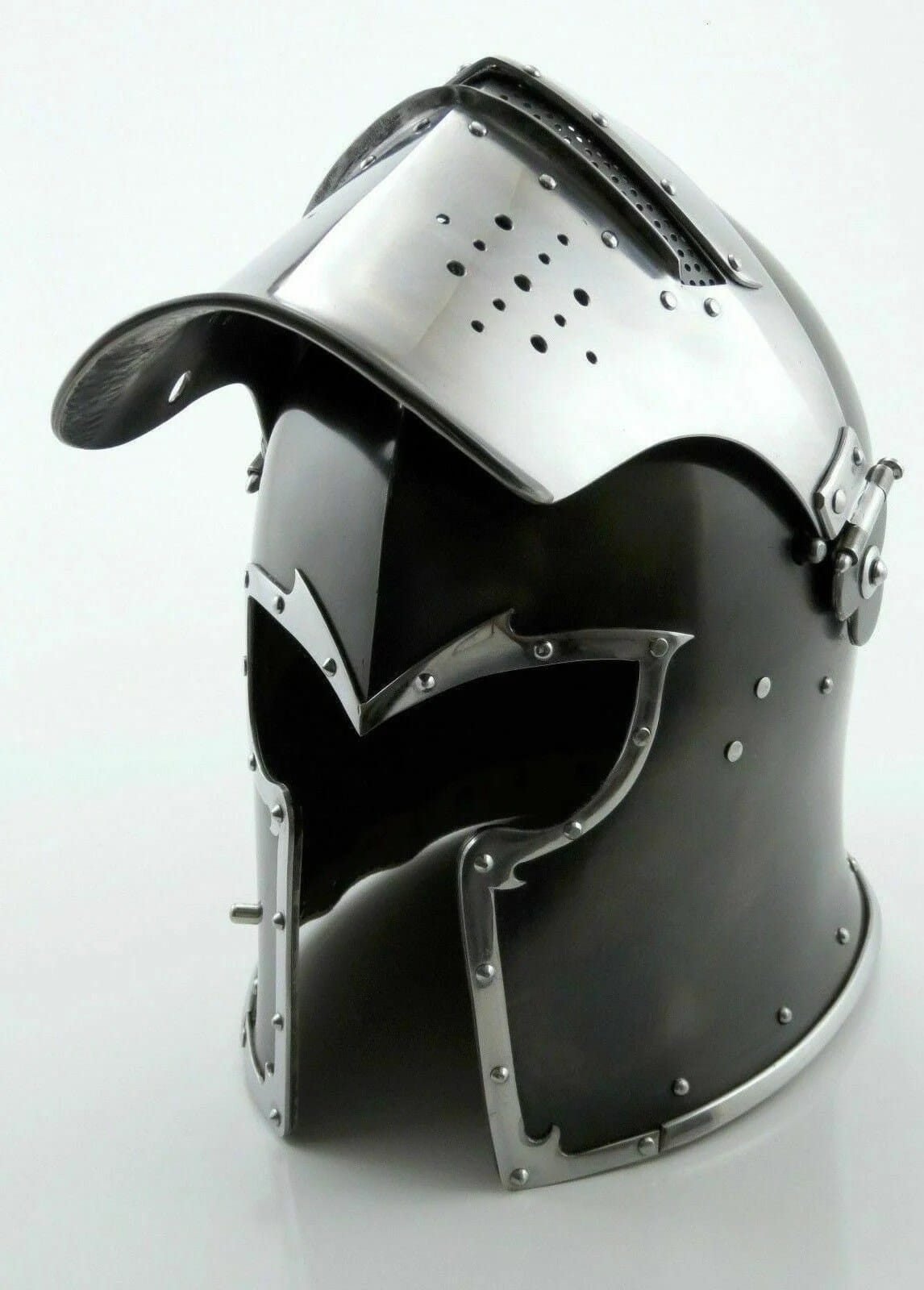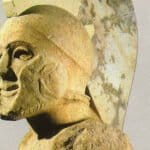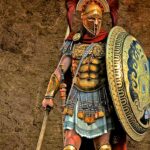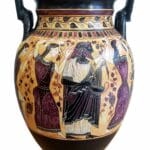Unveiling the Barbute: Design and Function
The barbute helmet, a striking piece of 15th-century Italian armor, represents a fascinating blend of practicality and medieval aesthetics. Its most recognizable feature is the distinctive T-shaped, or sometimes Y-shaped, opening for the eyes and mouth. Forged from steel, it offered a clever balance: substantial protection alongside a surprisingly good field of vision. This “open-faced” design may have been influenced by ancient Greek helmets, suggesting a resurgence of classical influences during the Italian Renaissance. [https://www.lolaapp.com/celtiberians]
Protection and Deflection
Unlike some helmets that aimed to absorb the full force of a blow, the barbute was probably designed to deflect it. This “glancing blow” strategy was likely particularly effective against the weaponry of the time. The angled surfaces of the barbute may have caused a sword blow to glance off, rather than striking the wearer’s face directly. Furthermore, the helmet extended down at the sides to protect the neck and jaw, while leaving peripheral vision unobstructed—a crucial advantage in the tumult of battle. [https://www.lolaapp.com/cavalry]
The Visor Debate
Early barbutes were typically visorless, prioritizing weight reduction and maintaining that all-important visibility. However, later variations featuring visors have emerged, sparking debate among historians. Some experts believe these might represent a later evolution of the design, perhaps straying from the core principle of deflection, while others question their classification as “true” barbutes. Ongoing research may eventually shed more light on these visored examples.
Who Wore the Barbute? Unmasking the Soldiers and Elite
The barbute wasn’t exclusive to one group, but likely worn by a variety of individuals across 15th-century Italy, from common soldiers to the upper echelons of society. Italy at this time was a patchwork of warring city-states, making armor a necessity. The barbute, with its distinctive face opening, appears to have been a popular choice.
From Foot Soldiers to Cavalry
Regular infantry and cavalry likely utilized barbutes for their balance of protection and visibility. Imagine the difficulty of fighting with severely restricted vision! The barbute offered a solution, shielding the head and neck without compromising battlefield awareness. While the average foot soldier might have worn a simpler barbute, wealthier individuals and high-ranking officers probably sported more ornate versions, featuring elaborate etchings, plush linings, or even gilding. This served not only as protection but also as a display of status and wealth.
The Venetian Garrison at Chalcis
Evidence suggests that the Venetian garrison stationed at the strategically important city of Chalcis also utilized barbutes. Venice, a major power with a vast trading empire and formidable military, likely equipped its troops with the best available gear. The inclusion of barbutes in their arsenal speaks volumes about the helmet’s effectiveness and perceived value.
| Wearer | Likely Reasons | Possible Variations |
|---|---|---|
| Foot Soldiers | Head and neck protection, reasonable visibility | Simpler designs, less ornamentation |
| Cavalry | Similar to foot soldiers, potentially adapted for mounted combat | Chin straps, added plume holders |
| Elite Figures | Status symbol, display of wealth | Elaborate etchings, gilding, linings |
| Venetian Garrison | Standard military issue, practical and effective | Possibly uniform design across ranks |
Further research into surviving examples and historical artwork might reveal even more about the barbute’s widespread use and the specific individuals who wore them. Our understanding of this fascinating helmet continues to evolve.
Barbute vs. Sallet: Key Differences in Medieval Helmet Design
The barbute and the sallet, both popular helmets in the 15th century, might appear similar at first glance, but they possess distinct characteristics. Understanding these differences provides a deeper appreciation for the complexities of medieval combat.
Design and Functionality
- Barbute: A smooth, rounded helmet, resembling an upside-down bowl, with a T- or Y-shaped opening. This design emphasized deflecting blows rather than absorbing them directly. The placement of the eye slits suggests a focus on defending against attacks from above, essential for both foot and mounted combat.
- Sallet: A more complex, wrapped design, sometimes extending to cover the back of the neck. Its defining feature is a movable visor, offering adjustable protection and a wider range of vision.
Regional Prevalence
- Barbute: Primarily found in Italy, reflecting the region’s innovative spirit during the Renaissance.
- Sallet: Popular across Western and Northern Europe, suggesting greater versatility and adaptability to diverse fighting styles and environments.
Evolutionary Impact
- Barbute: While not directly evolving into other helmet types, its simple yet effective design may have influenced later open-faced helmet designs.
- Sallet: Served as a precursor to more sophisticated helmets like the armet and close helmet, which offered more complete head coverage.
These differences highlight the varying priorities of medieval combat, with the barbute prioritizing facial protection and a classic aesthetic, and the sallet emphasizing mobility and adaptability. Ongoing research into materials and manufacturing techniques may further illuminate the evolution and usage of these helmets.
What is a Barbuta Helmet?
The barbuta, a 15th-century Italian helmet, stands apart from the typical image of a visored knight. Its distinctive T- or Y-shaped face opening offered a remarkable field of vision, a significant advantage in the chaos of battle, while still providing crucial protection.
Visibility and Breathability
Imagine the difficulty of wielding a weapon while peering through a narrow slit. The barbuta’s wide opening addressed this issue, allowing warriors a clearer view of their surroundings and easier breathing—vital during strenuous combat. It could be seen as a medieval precursor to modern open-faced helmets.
Construction and Metallurgy
The barbuta’s construction showcases the skill of Italian metalworkers. Typically forged from a single sheet of steel, the helmet often featured a hardened outer layer to deflect blows and a softer inner layer to absorb shock and prevent shattering. This sophisticated, two-layered design provided robust protection.
Protection and Design Influences
While not fully enclosed, the barbuta offered decent facial protection. Extended cheek plates shielded the cheeks and jawline, striking a balance between coverage and visibility. This likely made it a popular choice for both infantry and cavalry. Some historians suggest the barbuta’s design may have been influenced by the earlier bascinet, which was often worn with a separate visor.
Ongoing Research
Much remains to be discovered about the barbuta. Ongoing research continues to explore its role in medieval warfare, its construction techniques, and regional variations in design. Some experts believe there may have been differences in the shape and size of the face opening, or the thickness and treatment of the steel. While many questions remain, the barbuta, with its innovative balance of protection and visibility, holds a unique place in the history of medieval armor.
| Feature | Description |
|---|---|
| Face Opening | Distinctive T-shaped or Y-shaped opening, maximizing visibility while offering facial protection. |
| Cheek Plates | Extended plates protecting the cheeks and jawline. |
| Construction | Typically forged from a single sheet of steel, often with differentiated layers for impact absorption. |
| Metallurgy | Hardened outer layer for impact resistance, softer inner layer to prevent shattering. |
| Origin | Primarily associated with Italian soldiers during the 15th century. |
| Use | Probably favored by both infantry and cavalry due to its combined protection and visibility. |
- Discover Long Black Pepper: Flavor & Health Benefits - April 25, 2025
- Shocking Twists: The Grownup Review: Unreliable Narration - April 25, 2025
- A Quiet Place Book vs Movie: A Deep Dive - April 25, 2025

















2 thoughts on “The Barbute Helmet: A Medieval Marvel of Design and Protection”
Comments are closed.